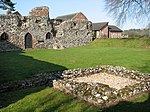Haddiscoe
Civil parishes in NorfolkUse British English from August 2018Villages in Norfolk

Haddiscoe is a village and civil parish in the South Norfolk district of Norfolk, England, about 16 miles (26 km) southeast of Norwich. The parish is on the county boundary with Suffolk, about 7 miles (11 km) west-northwest of Lowestoft. The parish includes the hamlet of Thorpe-next-Haddiscoe, about 1 mile (1.6 km) north of Haddiscoe village.The civil parish has an area of 19.88 km2 (7.68 sq mi). The 2011 Census recorded its population as 487 people in 210 households.
Excerpt from the Wikipedia article Haddiscoe (License: CC BY-SA 3.0, Authors, Images).Haddiscoe
The Street, South Norfolk
Geographical coordinates (GPS) Address Nearby Places Show on map
Geographical coordinates (GPS)
| Latitude | Longitude |
|---|---|
| N 52.51514 ° | E 1.60062 ° |
Address
The Street
The Street
NR14 6PN South Norfolk
England, United Kingdom
Open on Google Maps









